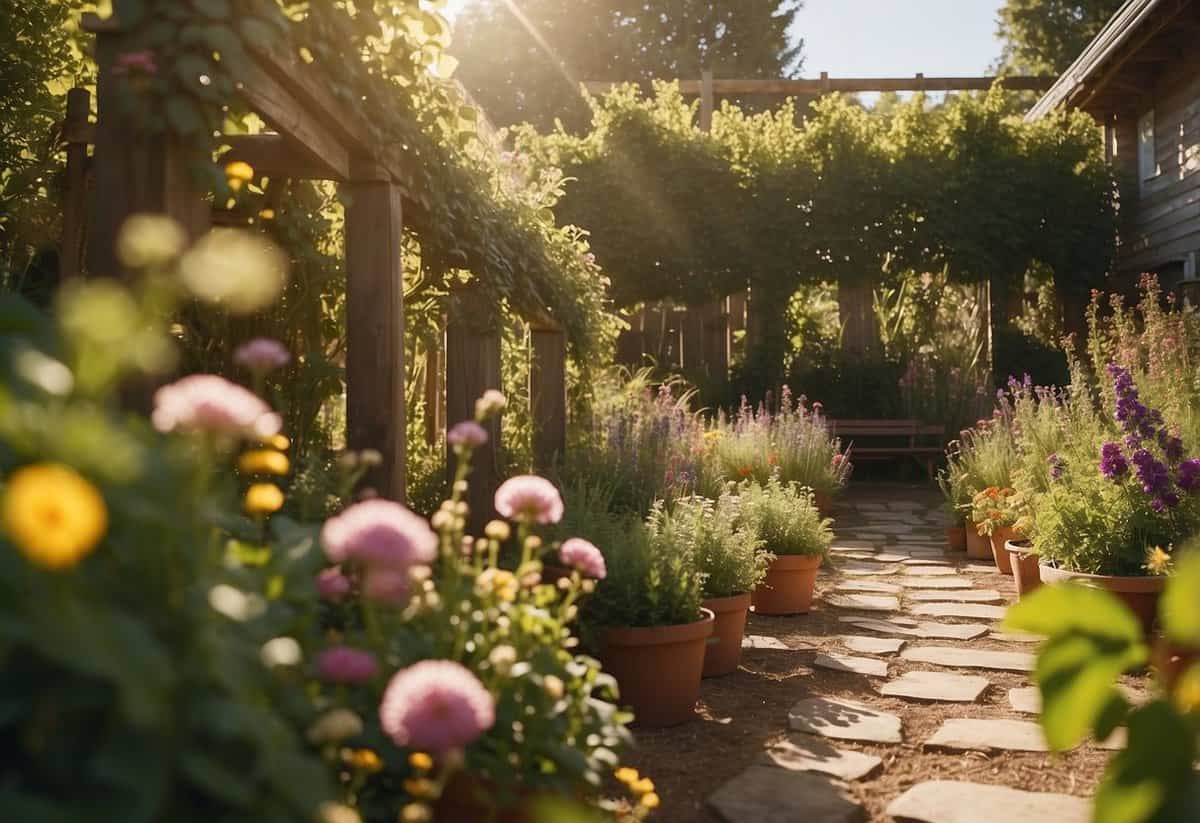Best Tips for Growing a Lush Vine Garden: Enhance Your Green Space
Growing a lush vine garden can transform any outdoor space into a beautiful, green oasis. Vines not only add vertical interest but also create a sense of privacy and seclusion. They are perfect for adding a touch of nature to walls, fences, and trellises.

To achieve a thriving vine garden, it’s crucial to understand the particular needs of the plants you choose. Whether you are a seasoned gardener or just starting out, this guide will provide you with essential tips to help your vine garden flourish.
1) Choose the Right Variety

Choosing the right variety of vines is crucial for a lush garden. Assess your climate and the amount of sunlight your garden gets.
Make sure to pick vines well-suited for your environment. For sunny spots, consider morning glories. For shady areas, try shade-loving vines.
Think about the type of vine you want. Flowering vines like sweet peas add color, while climbing vegetables like snap peas provide both beauty and food.
2) Provide Proper Support

Your vines need a strong support system to grow well. Use a trellis, pergola, or fence to help your vines climb. Make sure the support is stable and can handle the vine’s weight.
Secure the support firmly into the ground. This helps the vine grip and climb without falling over. Giving your vine enough room to spread its tendrils is also key for healthy growth.
3) Use Well-Draining Soil

Well-draining soil is crucial for growing healthy vines. To test your soil’s drainage, dig a hole about 12-18 inches deep and fill it with water. If the water drains quickly, your soil has good drainage.
Adding compost can also help improve soil drainage. Spread a layer of compost and mix it into the soil, reaching about six inches deep (source).
Make sure to use mulch around your plants. It helps conserve soil moisture but should not be too thick, as this can trap excess moisture (source).
4) Plant in Full Sun

To ensure your vines grow lush and healthy, choose a sunny spot in your garden. Many vines, like the honeysuckle, thrive in full sun and produce vibrant flowers.
Full sun helps your vines grow faster and bloom more. Look for varieties like the Purple Bell Vine, which loves the sunlight.
Keep the soil moist by adding mulch. This aids in retaining moisture and helps your vines stay hydrated and vibrant throughout the growing season.
5) Regular Watering

Keeping your vines hydrated is key to their growth. Water your plants at their base to avoid wetting the leaves, which helps prevent fungal diseases.
Use a drip irrigation system if possible. This method ensures water goes straight to the roots, reducing waste and keeping your vines healthy.
Watch the soil moisture levels. You’ll need to water more often during dry spells to maintain vibrant growth.
6) Prune for Shape and Health

Pruning is key to keeping your vines healthy and looking their best. Trim your honeysuckle vines after the flowering season, from April to June. Use clean and sturdy pruning shears, gloves, and possibly a lopper for thicker branches.
For neglected vines, start by removing dead or damaged branches. Make clean cuts to avoid damaging the vine, which helps prevent infection and disease. Stay consistent with your pruning schedule. This will encourage fresh growth and keep your garden looking vibrant.
7) Mulch to Retain Moisture

Using mulch is a great way to keep your vine garden hydrated. Mulch helps the soil retain moisture by reducing evaporation.
Try organic mulches like compost, which improves soil structure and provides nutrients. A good layer of 2 to 4 inches is ideal.
Mulch also regulates soil temperature, protecting your vines from extreme heat or cold. Make sure to keep mulch away from the stems to prevent rotting. For more details, you can check out this guide.
8) Fertilize Annually

Feed your vines with a balanced fertilizer once a year. Choose a fertilizer with a higher nitrogen content to promote lush, green growth. This will ensure your vines have the nutrients they need for healthy development.
Apply the fertilizer in early spring for the best results. This timing supports new growth as the weather warms up. Remember to follow the instructions on the fertilizer package to avoid over-fertilizing.
9) Control Pests and Diseases

Keep an eye out for pests and diseases in your garden. Early detection is key. Look for signs like damaged leaves or unusual spots.
Use organic pest control methods. Companion planting and natural repellents work well. Avoid harsh chemicals when possible.
Hand-picking pests can also help. It’s time-consuming, but effective. Encouraging natural predators in your garden can further reduce pest problems.
10) Train Vines Early

Start training your vines while they are still young. This helps guide their growth direction from the beginning. Use twist ties, plant clips, or flexible plant ties to attach the vines loosely to a support.
Keep an eye on the vines as they grow. As the tendrils grab onto the trellis, you can move the ties higher up.
Pinching off the tips of the vines when they reach the desired length can encourage branching. This will help your vines become fuller and cover the support more evenly.
Choosing the Ideal Location for Vine Gardens

Picking the right spot for your vine garden is key for growth. You need to consider sunlight as well as preparing the soil for healthy vines.
Determining Sunlight Requirements
Vines need the right amount of sunlight to thrive. Most vines require at least 6 hours of direct sunlight daily. If you’re growing vegetable vines, like tomatoes or beans, make sure they get plenty of sun. Some decorative vines, like clematis, prefer partial shade in the hottest parts of the day.
Observe your garden throughout the day to identify sunny and shady areas. Making a note of where the sun hits and for how long will help you choose the best spot. Be mindful of season changes; the angle of the sun can differ greatly from summer to winter.
Soil Preparation Tips
Rich, well-drained soil is essential for healthy vines. Start by testing your soil’s pH level. Most vines prefer slightly acidic to neutral soil. You might need to amend the soil to achieve the right pH balance. For robust growth, incorporate organic matter such as compost to increase fertility and improve drainage.
When preparing your soil, loosen it to at least 12 inches deep. This aids root development and helps your vines anchor well. Adding mulch can also help retain moisture and keep the soil temperature stable.
If space is tight, raised beds or containers can be effective alternatives, offering you more control over soil conditions.
Planting and Training Your Vines

Selecting the right vine species, giving them enough space, and using proper training techniques are key to growing a lush vine garden.
Selecting Suitable Vine Species
Choosing the right vine species for your garden is important. Some popular choices include Pothos, Wisteria, and Clematis. Pothos does well indoors with indirect light and minimal care. Wisteria prefers full sun and can thrive in well-drained soil. Clematis enjoys partial shade and requires rich, moist soil.
Keep in mind your climate and the amount of sunlight your garden receives. Match the vine’s needs with your garden’s conditions for the best results. Talk to local gardeners or visit a garden center for additional advice on vine species well-suited to your area.
Proper Spacing for Optimal Growth
Spacing plays a crucial role in the health of your vines. Vines need room to grow without crowding. If you plant them too close together, they will compete for nutrients, which may stunt their growth.
A general rule is to plant vines 12 to 36 inches apart, depending on the specific species. For example, Clematis should be spaced about 24 to 36 inches apart, while Pothos can be closer since they don’t spread as widely. Use a garden ruler or tape measure to ensure accurate spacing, and review seed packets for specific spacing guidelines.
Training Methods and Techniques
Training vines to grow where you want them enhances their natural beauty. Use supports like trellises, garden arches, or netting. Guide the vines gently as they grow by using plant ties, clips, or twist ties. Avoid tying them too tight to prevent damage.
Encourage the vines to grab onto supports by wrapping tendrils around them. Repeatedly check and adjust the ties as the vines grow. When the tendrils securely attach, you can move the ties higher up. If your vine species needs pruning, trim it regularly to keep it healthy and under control.
By following these steps, you’ll create a beautiful, organized, and thriving vine garden.
Maintaining a Healthy Vine Garden

Maintaining a healthy vine garden involves proper watering, fertilizing, and pest management. Each of these practices ensures your vines grow strong and vibrant.
Effective Watering Practices
Watering your vines properly is crucial. Most vines need consistent moisture. Deep watering helps their roots grow deep into the soil.
You should water your vines early in the morning. This allows the moisture to reach the roots before the sun gets too hot. Using a drip irrigation system can help water your vines evenly.
During dry spells, increase the frequency of watering. It’s important to check the soil moisture regularly. Over-watering can be as harmful as under-watering. Make sure the soil is well-drained to prevent root rot.
Fertilizing Strategies
Fertilizing your vines helps them grow stronger and produce more flowers. Use a balanced fertilizer, such as a 10-10-10 mix, which provides equal parts nitrogen, phosphorus, and potassium.
Apply fertilizer at the base of the plant. Avoid getting it on the leaves. This can cause burning. Early spring and mid-summer are the best times to fertilize your vines.
Consider using organic options like compost or fish emulsion. These provide nutrients and improve soil health. Don’t over-fertilize, as it can lead to excessive leaf growth and fewer flowers. Always follow the instructions on the fertilizer package.
Preventing and Managing Common Pests
Common pests can damage your vines, so it’s important to monitor them regularly. Aphids, spider mites, and caterpillars are some of the usual suspects.
Introduce beneficial insects like ladybugs and lacewings. They eat harmful pests and keep your garden healthy. You can also use insecticidal soap or neem oil to control pests.
Inspect your vines for signs of infestation. Look for discolored leaves, holes, and sticky residue. Remove any affected leaves and dispose of them properly. Keep your garden clean and free from debris to reduce pest habitats.







